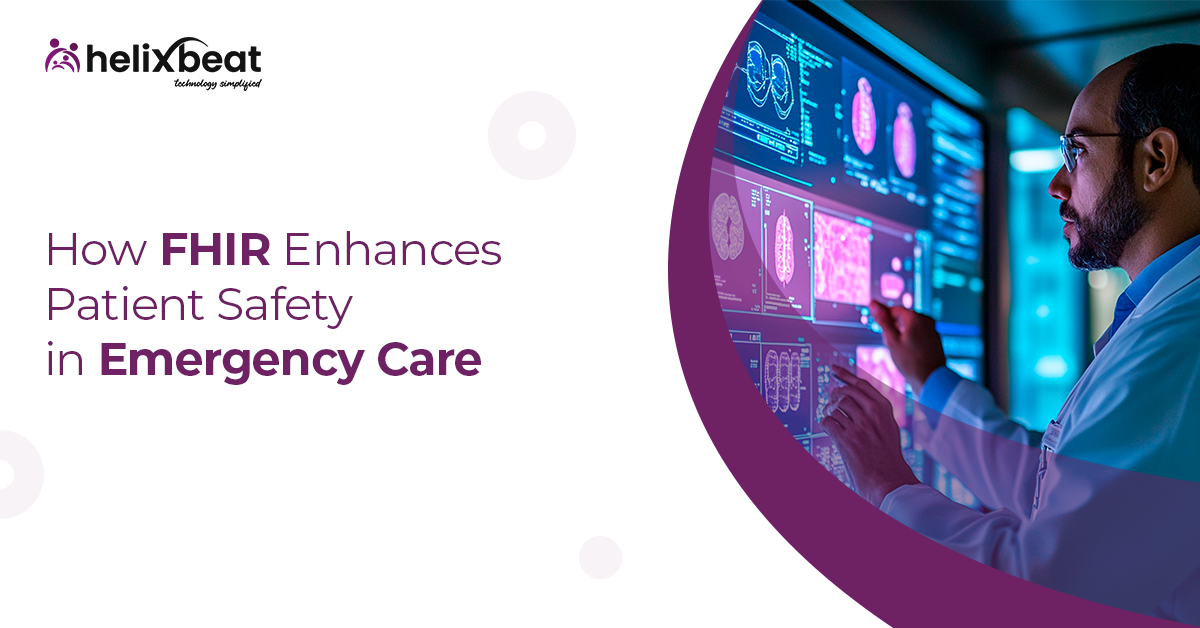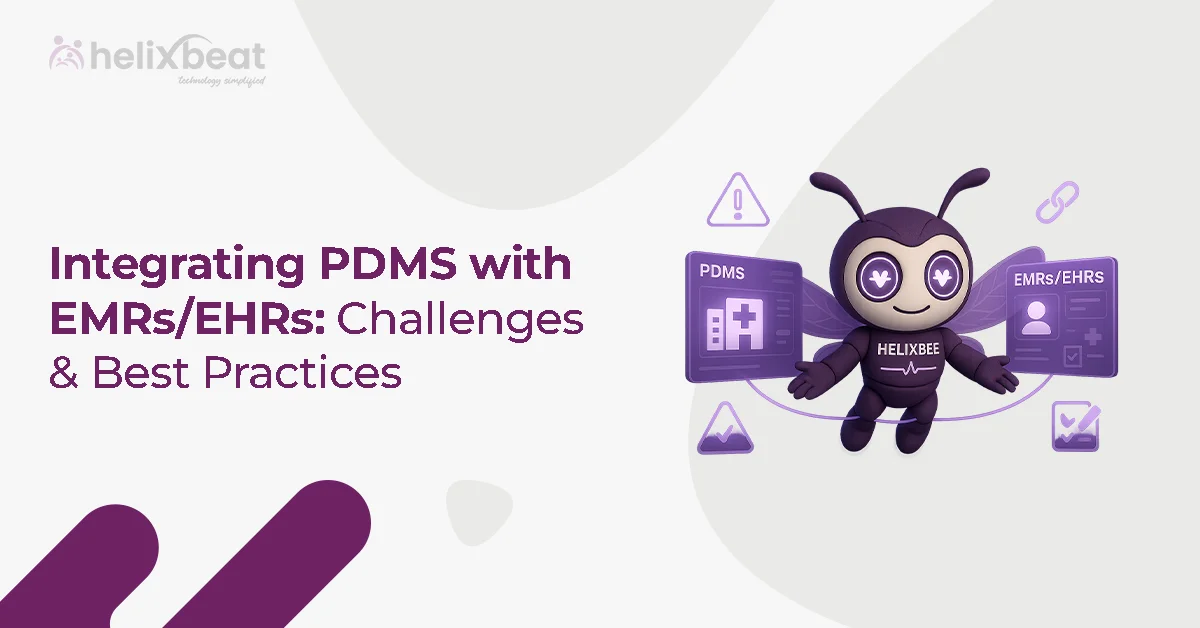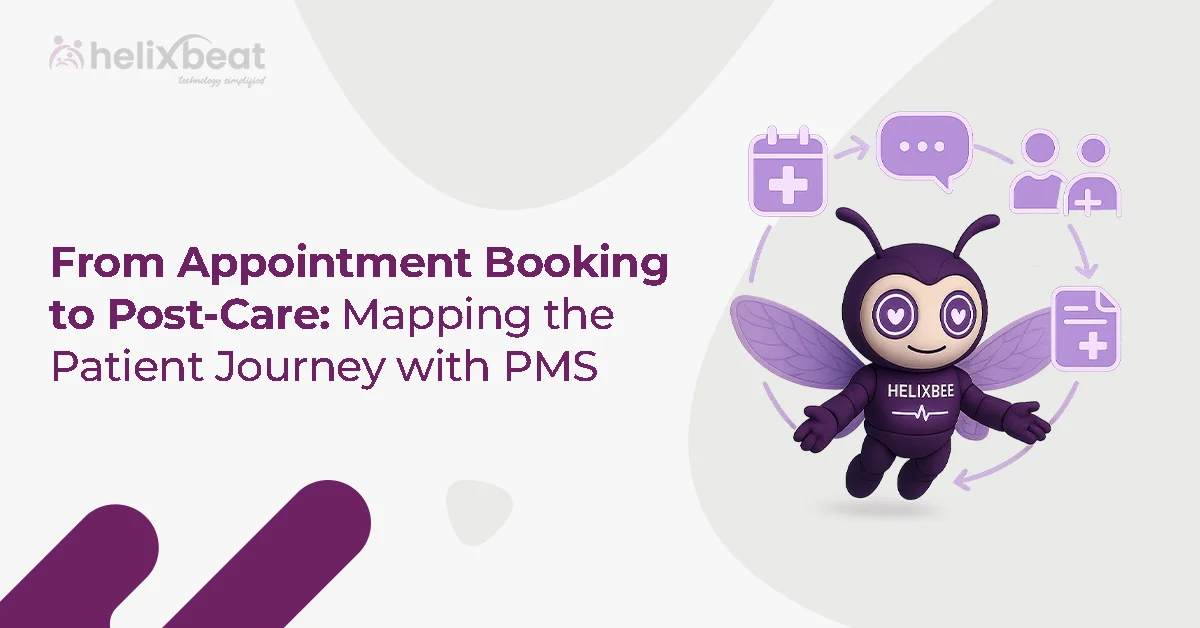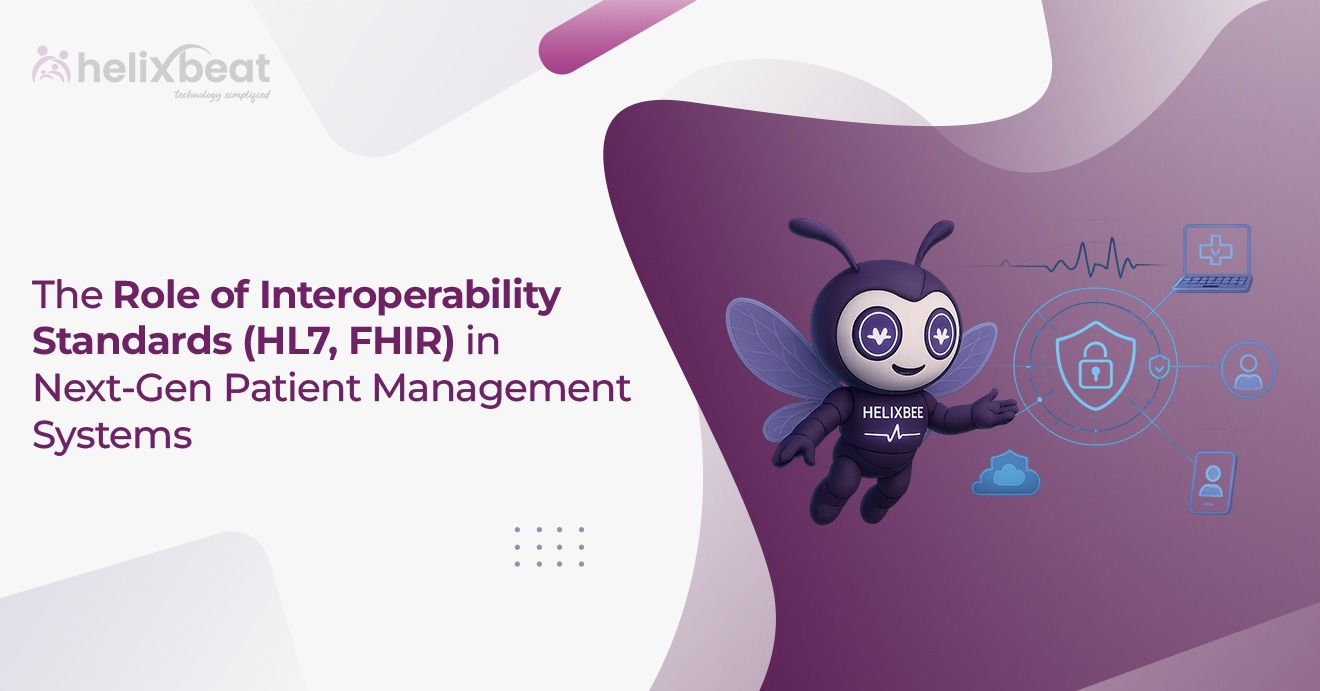In emergency healthcare settings, time is a noteworthy concern. Quick decisions made by doctors accurately can save many lives. If mistakes are due to incomplete or delayed information, they can lead to catastrophic outcomes. Present-day medical care providers rely on electronic health records (EHRs) and various medical systems that are often not interoperable, causing a fragmented approach to care.
This challenge is more pronounced in emergency care, where patients may present with unknown medical histories or data spread across multiple healthcare systems. The FHIR standard plays an extraordinary role in this context.
FHIR is the new healthcare interoperability standard that facilitates seamless healthcare data exchange across systems. It provides standardized formats and protocols that ensure the data is available, accurate, and up-to-date in time for patient safety during emergency care scenarios.
In this blog, we will see how FHIR helps in emergency care – that is, how FHIR improves data exchange, helps eliminate errors, aids clinical decision-making, and thus fosters improved coordination.
Table of Contents
1. What is the FHIR standard, and How Does It Work?
HL7 International initiated the FHIR standard to establish standards for electronically exchanging healthcare information. Each hospital stores patients’ health information in the system in particular formats. When these patient data are exchanged between different systems, the format can’t support and read the patient data. This is why we need FHIR. It addresses definitions of the Common format and exchange protocol for electronic health care information data.
Modern web technologies, such as restful APIs, differ from many access, interchange, and healthcare information management system tools. FHIR’s primary purpose is to improve interworking between varied healthcare systems for safer, seamless transfer across platforms.
FHIR structures the data into modular “resources,” where resources refer to units of healthcare information such as patient records, medications, allergies, lab results, and so on. Resources can be accessed singularly or as a composite, making them a fully formed patient profile. It uses standardized formats for these resources to ensure disparate systems can exchange information consistently.
In emergency care, the FHIR standard provides the capacity for healthcare providers to immediately access critical patient data to have all the necessary information needed to make real-time decisions swiftly and knowledgeably. For example, when a patient is brought into the emergency department (ED), the FHIR standard would be capable of allowing clinicians to access a patient’s medical history, medication list, allergies, and lab results from other healthcare providers and other institutions that are a part of the network.
Case study: Sarah’s story
FHIR (Fast Healthcare Interoperability Resources) plays a crucial role in enhancing patient safety and improving the quality of care in emergencies. Let’s consider the case of Sarah, a heart patient who is suddenly admitted to the hospital after experiencing chest pain.
Sarah arrives at the emergency department (ED) in distress. The healthcare providers need immediate access to her medical history to make quick, informed decisions. Traditionally, medical records might be scattered across different systems or institutions, delaying the process of retrieving critical information. However, the FHIR standard makes Sarah’s health information accessible in real time.
Using FHIR, the ED staff can instantly retrieve Sarah’s complete medical history, including her heart condition, previous treatments, current medications, allergies, and any recent lab results. For example, Sarah’s EHR (electronic health record) will show that she has a history of coronary artery disease and is currently taking blood thinners. This information allows the emergency team to quickly assess her condition and determine the appropriate course of action.
If Sarah needs a heart procedure, the FHIR standard ensures that all relevant data, such as her cardiac imaging and lab results, are immediately available to the cardiology team, even if they are located in a different part of the hospital or another facility. This seamless data sharing reduces delays, minimizes the risk of errors, and ensures Sarah receives the best possible care without unnecessary wait times.
In addition, the FHIR standard supports real-time updates. If Sarah’s condition changes during her stay, the healthcare team can continuously access and update her medical records, ensuring that they are always working with the most accurate information. Ultimately, the FHIR standard helps deliver faster, safer, and more coordinated care in emergencies, saving time and improving outcomes for patients like Sarah.
Let’s understand the challenges of emergency care without FHIR standards:
Challenges of emergency care without FHIR standard
Hospitals face numerous challenges in providing effective emergency care without the support of modern interoperability protocols like the FHIR standard (Fast Healthcare Interoperability Resources). In emergencies, time is of the essence, and the need for rapid, accurate decision-making is critical. However, hospitals struggle with fragmented healthcare data without an integrated system like the FHIR standard, leading to delayed treatment, increased risks, and, ultimately, poorer patient outcomes. Below are some of the key challenges hospitals face in emergency care without the FHIR standard:
1. Fragmented Patient Information
Patient data is typically locked in silos across departments and systems of the hospital if FHIR standards are not in existence. For example, a patient’s medical record, lab result, and imaging data could all be held separately in incompatible systems. In cases where a patient presents to the ED, a healthcare provider has to dig into multiple databases for comprehensive information.
This broken approach leads to delays because providers waste precious time searching for and piecing together disparate data sources. Without FHIR’s standardized interoperability, this process is cumbersome, and essential information may be overlooked, jeopardizing patient safety.
2. Delayed Decision-Making
Physicians and healthcare staff must make quick decisions to save lives in an emergency care setting. However, when patient data is not integrated into a centralized system, it leads to delays. If Sarah, for example, a heart patient, is admitted with chest pain, the emergency room (ER) team would need to review her medical history, medications, allergies, and previous heart-related conditions. Without FHIR’s real-time access to comprehensive data, there could be significant lag time in obtaining critical medical information, such as her history of coronary artery disease or medication regimen, delaying the diagnosis and treatment. This delay could be the difference between life and death in many emergencies.
3. Increased Risk of Medical Errors
Medical errors are one of the leading causes of patient harm in hospitals, especially in emergency care settings. One of the main reasons for these errors is the lack of access to complete, up-to-date patient information. For example, suppose a patient like Sarah has allergies to certain medications, but this information is unavailable in the ER due to a fragmented system. In that case, the risk of administering a harmful drug is heightened. Similarly, if her current medications are not accurately reflected in her emergency chart, dangerous drug interactions might occur. Without the standardized data-sharing capabilities of the FHIR standard, the likelihood of such errors increases, putting patients at greater risk.
4. Inefficient Communication Between Departments
Emergency care is often multidisciplinary and thus involves the services of various departments, including emergency physicians, nurses, specialists, and lab technicians. Without FHIR, information in these different groups might not be efficiently communicated. Each department might have used different systems to store and manage patient data, so it is hard to share it quickly and update it immediately.
In Sarah’s case, if she is to be moved to the cardiology unit for further treatment, the transfer of her medical records may not occur or may not be complete. Without seamless data exchange, it becomes difficult for teams to coordinate; hence, wait times increase, and confusion and even risks to the patient may result.
5. Inability to Access External Health Records
Patients who come to emergency care may come from different healthcare providers or different parts of the region, and the medical records might not be immediately available to the attending physician. Without the FHIR standard, it’s harder for hospitals to integrate health records from external sources, such as primary care physicians or specialists.
In Sarah’s case, had she been taken to a different facility for her heart condition, the hospital might not have had easy access to her previous medical history. This delay in accessing such records can also delay treatment since the ER team would need to request such records from other providers or attempt to contact her primary care physician, which can take hours.
6. Inconsistent Data Standards
In the absence of FHIR standards, hospitals use older and inconsistent data formats and standards, making it more challenging to understand and share patient information. For example, some systems store data in proprietary formats that other systems cannot read or understand, thereby complicating data sharing.
In emergency settings, where every second counts, inconsistency in data standards could hamper effective decision-making. The ER team may waste time converting data from one system to another or struggle to understand fragmented pieces of information, which can delay treatment and increase the risk of mistakes.
7. Lack of Real-Time Updates
Health Conditions may change rapidly with a patient. Without FHIR, hospitals find it difficult to update and share information in real-time. For example, when Sarah’s heart condition worsens or when she has a major allergic reaction, the attending physician needs instant access to updated records. In the absence of FHIR, the updates may not be communicated promptly across different departments in the hospitals or external providers, which delays care and leaves the possibility open for doctors acting on outdated information.
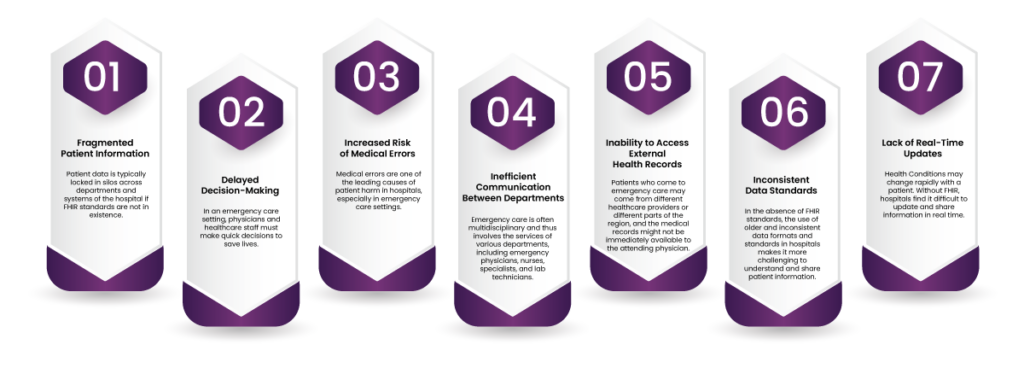
How FHIR Enhances Patient Safety in Emergency Care
A. Real-Time Access to Critical Patient Information
One of FHIR’s key benefits is its ability to provide real-time access to patient data. This is crucial in emergency care. When patients arrive at the ED, healthcare providers need access to their medical history, current medications, allergies, and previous treatment information. Without this information, clinicians are left to make decisions based on limited or incomplete data, which can lead to mistakes.
FHIR facilitates the real-time sharing of patient data across systems, enabling healthcare providers to access comprehensive and up-to-date medical records. This allows clinicians to quickly assess the patient’s condition and make informed decisions, which is especially important in emergencies where every second counts.
For example, suppose a patient is brought in after a car accident and is unconscious. In that case, the emergency team may not obtain a history of the patient’s allergies or medications. However, using FHIR, the healthcare team can immediately retrieve this information from the patient’s existing EHR or other connected systems, helping to prevent dangerous allergic reactions or drug interactions.
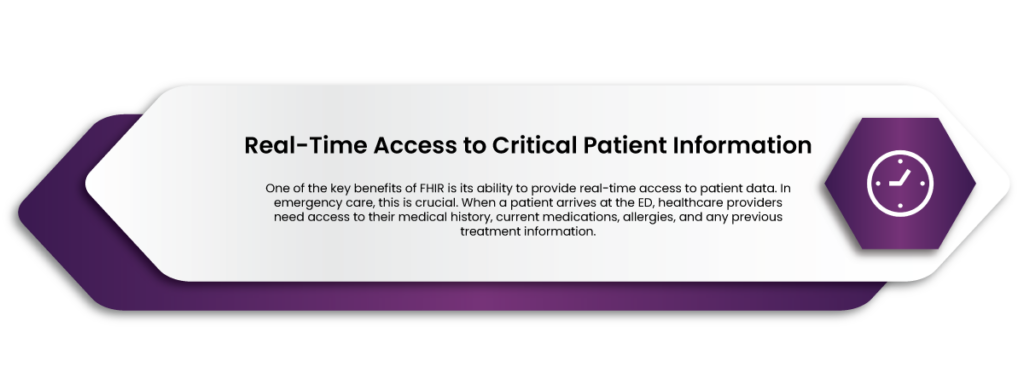
B. Minimizing Data Entry Errors
In emergency settings, clinicians are often under significant pressure to provide care quickly. This high-stress environment can increase the risk of errors, especially when it comes to data entry. Clinicians may make mistakes when entering patient information, such as the wrong medication dosage or mislabeling lab results. These errors can have serious consequences, particularly in an emergency care setting.
FHIR helps mitigate these risks by reducing the need for manual data entry. Through the use of automated data exchange and integration, FHIR ensures that information flows directly between systems without the need for human intervention. For instance, when a prescription is written in the ED, it can automatically be sent to the pharmacy system via FHIR, ensuring the correct medication is dispensed without requiring the clinician to enter prescription details manually.
By eliminating manual processes and automating data exchange, FHIR reduces the chances of human error and ensures that the right information is provided at the right time.
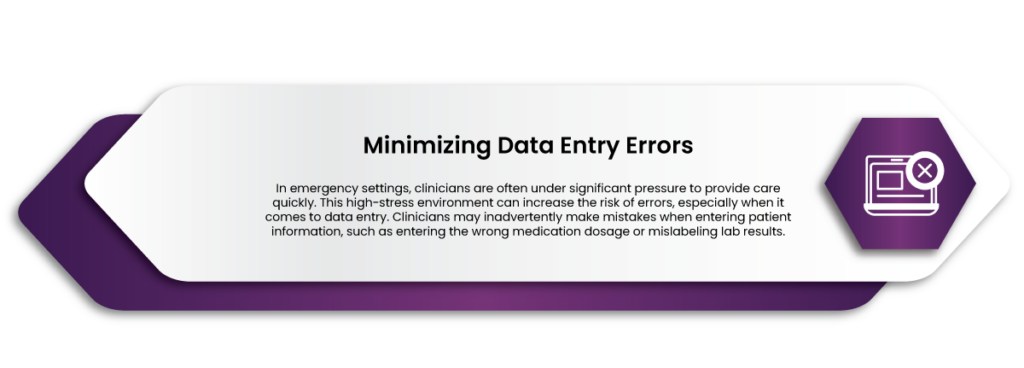
C. Enhancing Decision Support Systems
Clinical decision support (CDS) systems play a vital role in emergency care by providing healthcare professionals with timely, evidence-based recommendations. These systems rely on accurate and up-to-date data to offer relevant suggestions for patient care. FHIR enhances the effectiveness of CDS systems by ensuring they have access to comprehensive patient data across different healthcare systems.
For example, when a patient presents with chest pain, a CDS system can analyze the patient’s medical history, risk factors, lab results, and other relevant data in real time. Based on this information, the system can provide recommendations such as ordering specific tests or administering certain medications. FHIR improves the decision-making process and helps prevent errors that could negatively impact patient safety by ensuring that the CDS system has access to the most current and accurate data.
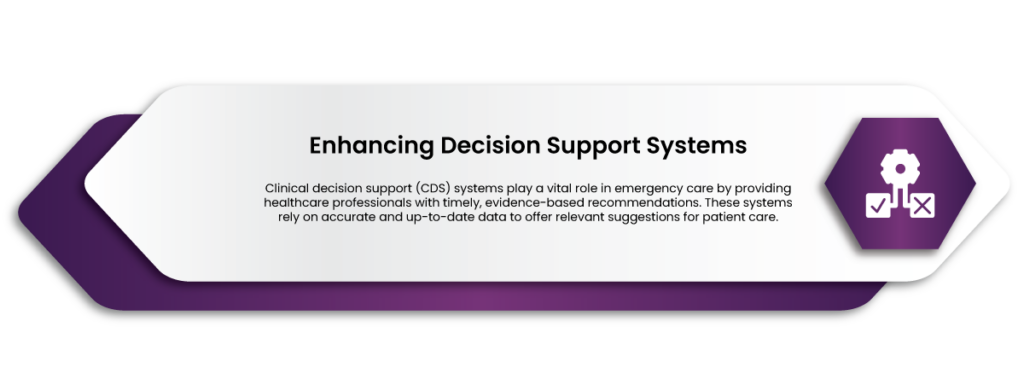
D. Supporting Cross-Provider Collaboration
Emergency care often involves multiple healthcare providers working together to assess and treat a patient. This might include the ED team, specialists, paramedics, and other healthcare professionals. However, collaboration between these providers is often hampered by the lack of interoperability between different healthcare systems. FHIR facilitates seamless communication between healthcare providers by ensuring all providers have access to standardized data.
Using FHIR, emergency care teams can share critical patient information such as lab results, imaging studies, and medical histories with other providers in real time. For example, suppose a patient is transferred from one hospital to another for specialized care. In that case, FHIR ensures that the receiving facility can access the patient’s most up-to-date records, allowing the new team to continue care without delays. This collaboration helps ensure that patients receive continuous and coordinated care, which is vital for their safety.
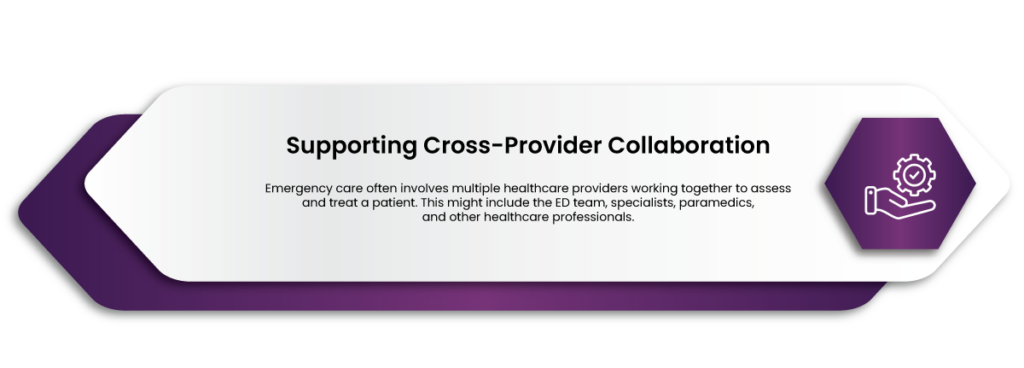
E. Reducing Medication Errors
Medication errors are a leading cause of patient harm in emergency care settings. These errors can occur when patients are prescribed the wrong medication or dosage or when they experience drug interactions that are not identified until after the medication is administered. FHIR helps reduce medication errors by providing healthcare providers with accurate and up-to-date medication lists that are automatically synchronized across systems.
For example, when a patient arrives at the ED and is prescribed medication, FHIR ensures that the medication history, including any allergies or adverse reactions to specific drugs, is immediately available to the clinician. This prevents clinicians from prescribing medications that could cause harm. FHIR also allows for automatic checks for potential drug interactions and allergies, further reducing the risk of medication errors.
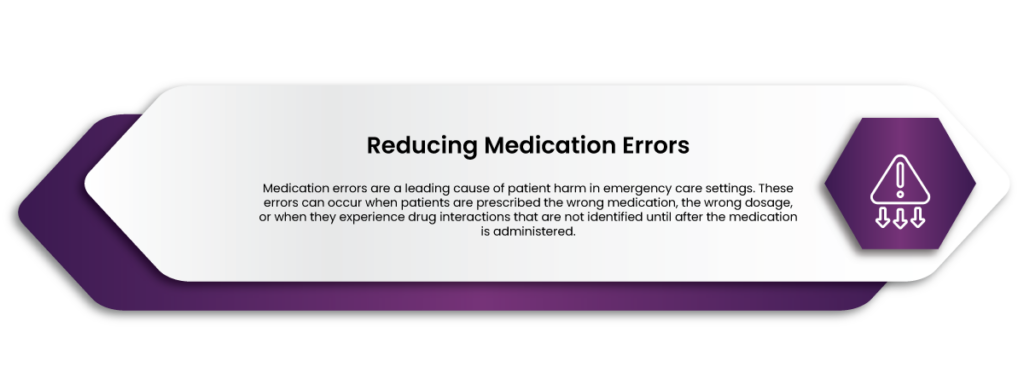
F. Improving Patient Identification
Accurate patient identification is crucial to patient safety, especially in emergency care settings where patients may not be able to provide their details due to their condition. Patients may sometimes present with similar names, or records may be incomplete, leading to confusion and misidentification. This can result in a range of adverse outcomes, including the administration of incorrect medications, incorrect procedures, or delayed treatment.
FHIR helps address this issue by allowing for reliable, standardized patient identification. Through the use of unique patient identifiers and advanced matching algorithms, FHIR ensures that patient data is accurately linked to the right individual, reducing the risk of misidentification. In emergency care, where patients may be unable to communicate their details, FHIR ensures that clinicians still correctly identify and access their health records.
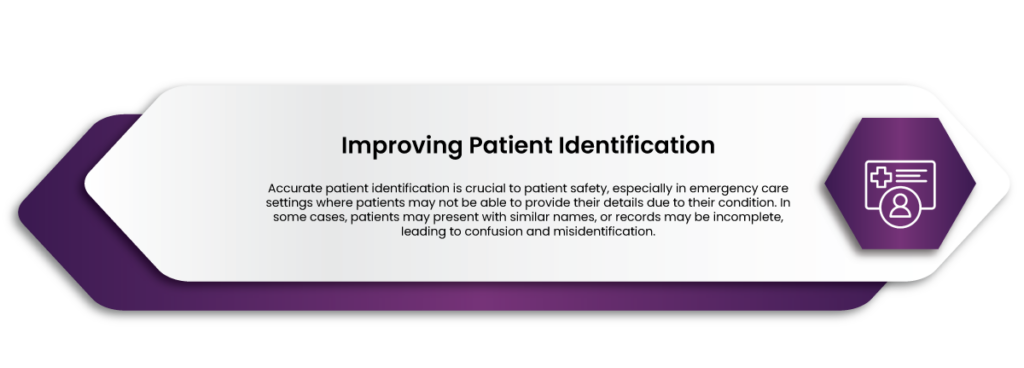
G. Facilitating Remote Consultations and Telemedicine
In some emergency care scenarios, remote consultations with specialists may be necessary, especially in rural or underserved areas. FHIR supports telemedicine by enabling the secure exchange of patient data between healthcare providers, even when they are in different locations. This is particularly valuable in emergency care, where timely access to expert opinions can significantly improve patient outcomes.
For example, a patient presenting with a severe allergic reaction may require an immediate consultation with an allergist. Using FHIR, the emergency team can securely share the patient’s medical records, lab results, and history with the allergist in real time, allowing them to provide expert guidance without delay. This improves patient safety by ensuring that the patient receives the appropriate care as quickly as possible.
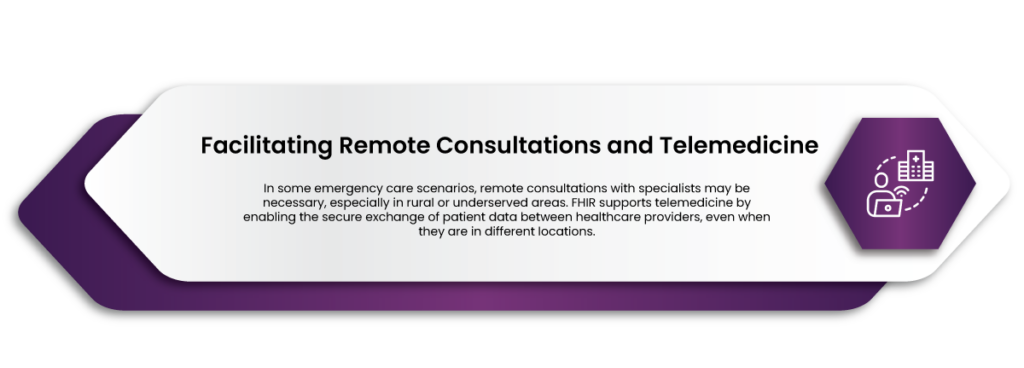
How Fusion FHIR Standard Helps in Emergency Care
The Fusion FHIR (Fast Healthcare Interoperability Resources) standard plays a transformative role in overcoming the challenges of fragmented healthcare systems by providing a standardized approach to data sharing and integration. Here’s how Fusion FHIR enhances emergency care:
1. Seamless Interoperability
Fusion FHIR enables seamless data exchange between disparate systems, ensuring that emergency care teams have instant access to a patient’s medical history, allergies, medications, and lab results. By connecting hospital electronic health records (EHRs) with external providers, Fusion FHIR eliminates the delays caused by siloed systems.
For example, suppose a patient arrives at the emergency room after a car accident. In that case, the attending physician can quickly retrieve their critical medical information from other healthcare facilities, enabling faster diagnosis and treatment.
2. Real-Time Updates
Patient conditions can change rapidly in emergency scenarios. Fusion FHIR allows for real-time updates across all connected systems, ensuring that the most up-to-date information is available to all healthcare providers involved. This capability significantly reduces the risk of errors caused by outdated information.
3. Enhanced Communication
Emergency care often involves collaboration among multiple departments and specialists. Fusion FHIR standard acts as a universal language, enabling efficient communication and data sharing across teams. It ensures that everyone, from paramedics to emergency physicians and specialists, has access to the same accurate and updated patient data.
4. Improved Patient Safety
Fusion FHIR standard minimizes the risks of medical errors by providing comprehensive patient data at the point of care. For instance, if a patient has an allergy to a specific medication, Fusion FHIR ensures this information is readily available, preventing potentially harmful treatments.
5. Faster Decision-Making
With the Fusion FHIR standard, emergency care providers can make informed decisions faster. Instant access to a patient’s health history, lab results, and imaging studies allows for quick diagnosis and the formulation of effective treatment plans. This speed can be life-saving in critical cases such as cardiac arrests or trauma injuries.
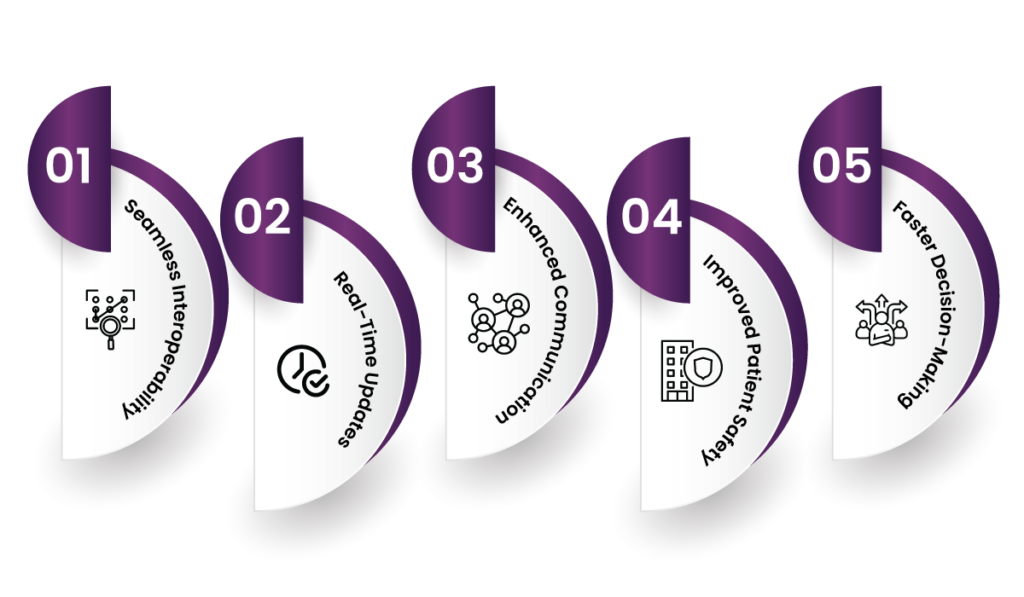
Case Study: How Fusion FHIR Standard Saved a Heart Patient
Background
Sarah, a 58-year-old heart patient, experienced severe chest pain and was rushed to the emergency room. She had a history of coronary artery disease and was on multiple medications prescribed by different specialists.
Challenges
Without the Fusion FHIR standard, the hospital’s emergency care team would have faced significant challenges:
- Difficulty accessing Sarah’s complete medical history from different healthcare providers.
- There could be delays in diagnosing her condition due to the lack of integration between lab results, imaging, and previous treatments.
- Increased risk of medical errors, such as prescribing a contraindicated medication.
How Fusion FHIR standard Helped
Upon Sarah’s arrival, the hospital’s Fusion FHIR-enabled system integrated her data from various sources, including her primary care physician and cardiologist. Within seconds, the emergency team had access to:
- Sarah’s detailed medical history.
- A list of her current medications and known allergies.
- Results from her most recent stress test and imaging studies.
Using this data, the team quickly identified that Sarah was experiencing a myocardial infarction (heart attack). The attending physician immediately initiated appropriate treatment, including administering clot-busting drugs and preparing her for an emergency angioplasty.
Outcome
Sarah received timely, accurate care, significantly improving her chances of recovery. The integration powered by Fusion FHIR ensured that the team avoided delays and potential errors, delivering life-saving treatment in record time.
Conclusion
FHIR is revolutionizing emergency care by ensuring seamless, real-time data exchange and fostering interoperability across healthcare systems. Its ability to provide accurate and up-to-date patient information minimizes delays, enhances decision-making, and reduces medical errors.
Fusion’s FHIR standard empowers healthcare teams to collaborate effectively and deliver timely, life-saving care. The FHIR standard improves patient safety and outcomes in critical situations by overcoming challenges such as fragmented data and inconsistent standards. As the healthcare landscape evolves, adopting FHIR standards will be pivotal in creating a more connected, efficient, and patient-centric approach to emergency care, ultimately saving lives and enhancing care quality.
Frequently asked question
- What is FHIR, and how does it work in healthcare?
- FHIR (Fast Healthcare Interoperability Resources) is a standard developed by HL7 for exchanging healthcare information electronically. It uses modern web technologies like RESTful APIs to ensure seamless data sharing between healthcare systems.
- How does FHIR improve patient safety in emergency care?
- FHIR enhances real-time access to patient data, minimizes errors through automated data exchange, supports clinical decision-making, and enables better collaboration between healthcare providers.
- What challenges do emergency care providers face without FHIR?
- Without FHIR, providers face fragmented patient data, delayed decision-making, increased risk of errors, inefficient communication, and difficulties accessing external medical records.
- How does FHIR support real-time decision-making in emergency settings?
- FHIR provides immediate access to critical patient data, such as medical history, medications, and allergies, helping clinicians make informed and timely decisions.
- What role do FHIR resources play in emergency care?
- FHIR organizes healthcare data into modular “resources” (e.g., patient records, medications, lab results). These resources allow seamless data exchange, ensuring accurate and comprehensive patient information is available.
- Can FHIR prevent medical errors in emergencies?
- FHIR reduces medical errors by providing accurate and up-to-date information, automating data exchange, and minimizing manual data entry.
- How does FHIR improve communication between hospital departments?
- FHIR enables standardized, real-time data sharing across departments, ensuring that all teams have access to the same patient information.
- Does FHIR integrate with existing EHR systems?
- FHIR is designed to integrate with electronic health records (EHRs) and other healthcare systems, enhancing their interoperability.
- How does FHIR handle patient data security and privacy?
- FHIR incorporates robust security protocols and works with existing healthcare standards to ensure secure and compliant data exchange.
- Can FHIR access external medical records in emergencies?
- Yes, FHIR enables healthcare providers to access patient data from external systems, improving continuity of care in emergencies.
- How does FHIR assist in clinical decision support (CDS) systems?
- FHIR provides CDS systems with comprehensive patient data, enabling them to offer accurate, evidence-based recommendations for treatment.
- What are the benefits of using FHIR for cross-provider collaboration?
- FHIR ensures that patient data can be shared seamlessly between different providers, improving care coordination and reducing treatment delays.
- How does FHIR minimize the risks of data entry errors?
- FHIR automates data exchange, reducing reliance on manual entry and preventing common errors like incorrect dosages or mislabeled test results.
- What types of emergencies benefit most from FHIR implementation?
- FHIR is beneficial in all emergencies but is particularly impactful in cases requiring rapid decision-making, such as cardiac events, trauma, or severe allergic reactions.
- Is FHIR compatible with future healthcare technologies?
- FHIR is designed with scalability and modern web standards, making it compatible with emerging healthcare technologies and innovations.



